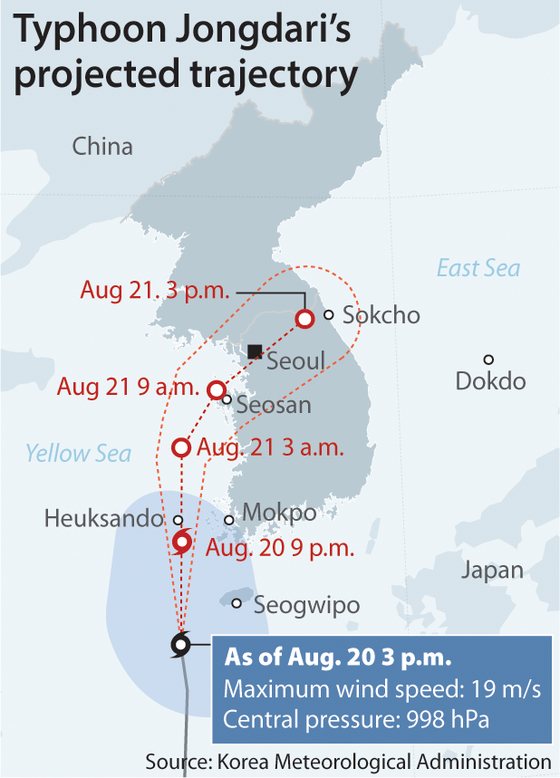Korea battens down the hatches as Typhoon Jongdari approaches
Published: 20 Aug. 2024, 19:07
Updated: 20 Aug. 2024, 19:09
![Rough waves heave in the coastal waters of Sagye-ri, Seogwipo City on Jeju Island, on Tuesday as a typhoon alert was issued for the region. Typhoon Jongdari continues its northward advance and is expected to make landfall near Seosan, South Chungcheong, on Wednesday morning. [NEWS1]](https://koreajoongangdaily.joins.com/data/photo/2024/08/20/a8c73505-259a-449e-9d9c-fdcff54cb225.jpg)
Rough waves heave in the coastal waters of Sagye-ri, Seogwipo City on Jeju Island, on Tuesday as a typhoon alert was issued for the region. Typhoon Jongdari continues its northward advance and is expected to make landfall near Seosan, South Chungcheong, on Wednesday morning. [NEWS1]
Korea was bracing for strong winds and heavy rainfall, with Typhoon Jongdari on track to become the first typhoon to make landfall on the peninsula.
Torrential downpours and gusts lashed Jeju Island on Tuesday as it came under the influence of the typhoon, which continued its trajectory northward.
By 3 p.m. Tuesday, the typhoon was passing through seas 120 kilometers (74 miles) southwest of Seogwipo, Jeju Island, fanning maximum sustained winds of 68 kilometers per hour, according to the Korea Meteorological Administration (KMA).
The KMA predicts the typhoon will continue its northward advance, passing near Heuksando — an island in the Yellow Sea — on Tuesday night before weakening into a tropical depression on Wednesday morning. The storm will make landfall near Seosan, South Chungcheong, around 9 a.m. on Wednesday and dissipate near Sokcho, Gangwon, by 3 p.m.
If the typhoon — the ninth typhoon of the year — follows this projected path, it will be the first typhoon to make landfall in South Korea since the deadly Typhoon Khanun on Aug. 10 of last year.
South Chungcheong and parts of the Seoul metropolitan area, located in the path of the tropical low-pressure region, are expected to receive up to 80 millimeters of rain through Wednesday, while Jeju and the southern coast of the country are forecast to receive up to 100 millimeters of rain.

As the storm approached, Jeju Island — located near its path — began experiencing its effects on Tuesday afternoon, with heavy downpours and strong winds. Torrential rain of up to 29.9 millimeters per hour drenched Samgakbong Peak on Mount Halla, resulting in 76 millimeters of total rainfall by 4 p.m. The peak also recorded maximum sustained wind speeds of 23.9 meters per second.
The storm also brought massive waves, leading to the cancellation of all passenger ships scheduled to pass through Jeju’s coastal ports after 4 p.m.
At Jeju International Airport — where alerts were issued for sudden changes in wind direction and speed — 43 domestic flights and three international flights were canceled as of 2 p.m. on Tuesday.
Access to all seven hiking trails on Mount Halla was also restricted.
The Korea Forest Service raised the nation's four-tier landslide alert level to the second-highest “caution” on Tuesday.
In preparation for potential typhoon damage, Jeju Special Self-Governing Province on Tuesday elevated its three-level emergency duty system to Level 2. This placed 10 percent of personnel across its 13 offices and bureaus on emergency duty.
The Ministry of Interior and Safety activated a level 1 emergency operation of the Central Disaster and Safety Countermeasures Headquarters and elevated the warning level to "caution" from the previous "attention" at 8 a.m. on Tuesday.
Interior Minister Lee Sang-min called for thorough preparatory measures to minimize damage.
As the typhoon draws in hot and humid air from the south, the ongoing heat wave is expected to persist, with tropical nights likely continuing nationwide for the time being.
Seoul experienced its 30th consecutive tropical night on Tuesday, extending its streak to the longest on record since modern meteorological observations began in 1907.
Incheon and Busan are also breaking their own records for the longest streak of tropical nights, continuing for 28 and 26 days, respectively.
Typhoon Jongdari developed around 3 a.m. on Monday, approximately 290 kilometers southwest of Okinawa, Japan.
Typhoon Jongdari was named after the Korean word for skylark and was chosen by North Korea's weather agency.
BY WOO JI-WON [woo.jiwon@joongang.co.kr]










with the Korea JoongAng Daily
To write comments, please log in to one of the accounts.
Standards Board Policy (0/250자)